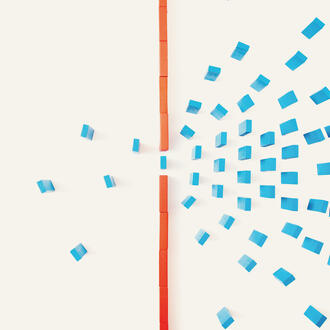Ideas Made to Matter
A 4-step process for recovering from business disruption
By
With the United States officially in a recession and the future spread of coronavirus unclear, companies experiencing disruption from COVID-19 have little control over when things will return to normal.
While timing is uncertain, demand will return — and companies do have the power to prepare for when that time comes, according to MIT Sloan senior lecturer
In a recent webinar, Carrier outlined a system dynamics-based approach, a military decision-making process known as an OODA loop, for how companies can prepare for a quick recovery from this disruption and others in the future.
Technology can play a key role in response to disruptions, Carrier said, but it shouldn’t be the only focus — people and creativity are also fundamental elements. And while Carrier’s research is based on physical work such as manufacturing, it can also apply to knowledge work.
Use the OODA loop to improve responses
The pandemic has been the “shock of a generation,” and a decade of stable growth left companies ill-equipped to handle disruption, Carrier said.
“Organizations encourage decay during periods of stability,” he said. “We lose the ability to respond to external shocks.”
Leaders must keep their companies resilient by running simulations and scenarios, or what Carrier calls “winning the fire drill.”
“Most of their success that we see during execution was actually won during preparation,” he said.
And beyond looking at recovery from the pandemic crisis, companies should aim to keep their response capabilities from eroding.
“By making a problem go away, we’ve done nothing to improve the system’s response to the next crisis,” Carrier said.
The OODA loop, a concept first used by U.S. Air Force Col. John Boyd to improve fighter jet performance during the Korean War, is one method for finding improvements. Boyd realized that success is determined by overall response time, not just technical superiority. The OODA loop process involves thinking about where to invest time and money to develop faster responses.
The loop includes four steps: observe what has changed in the environment; orient, or discover your current state in the environment; decide how to adjust the company in response to the new environment; and act, or take deliberate action based on previous experience and standards. The process is iterative and the cycle is repeated.
“In life we’re constantly running OODA loops,” Carrier said. “Think about riding a bike or driving a car, you’ve run several hundred of them.”
To start an OODA loop process for recovery from disruption, Carrier said, assemble a team of four to eight people, ask a set of questions relative to recovery — such as what you will do if a supplier cannot meet your needs — and select some “what if” scenarios to have in mind as you work.
Then, move through the OODA loop. In each step look for digital technologies that can support your work.
Observe
Gather information about what’s happening inside and outside the company, including any available data. Ask what leading indicators you wish you had, what sort of technology you could be using to get those indicators, and who you can ask for information, including vendors or others in the supply chain.
In the case of a small to midsize industrial or aerospace manufacturer, the challenge is predicting when demand will return. Carrier said the manufacturer could look to companies that can provide information about demand in other parts of the supply chain for demand signals and real-time data from the factory floor.
Orient
Use information gained from observation to focus on the state of your equipment and facilities, and who is using what technology in the company, Carrier said.
“This is where GPS, RFID, and ubiquitous sensors can be really valuable” for many companies, Carrier said. “Who are the people who are currently using this technology, both inside and outside the company, who can they help us figure this out relatively quickly?”
This sort of situational awareness can help you in the next step.
Decide
Leaders have to make difficult decisions in short time frames. Seek ways to use technology to help you decide in real time. For example, bad weather can threaten capital-intensive assets like wind turbines and oil and gas rigs, as well as the people working on and around them. Companies like MIT Startup Akselos use engineering software to deliver precise information about what has to be shut down and when, eliminating guesswork.
Act
You have made decisions and it is time to act. Your first question should be “Who else has done this?” Carrier said.
Look to other industries doing similar things. Seek digital technologies that can help you act in safer and more efficient ways. For example, medical professionals are using telehealth technologies to treat patients without putting anyone at risk from personal contact.
The four OODA steps combine to make a closed feedback loop.
“As humans, we are mostly unaware of the feedback loops that guide the performance of a system, even the ones we created,” Carrier said. “In the age of Industry 4.0, the problem is no longer that technology is too expensive, but knowing how to recognize a missing or deficient OODA loop so that it can be improved.”
Remember: Adaptation, not optimization
When going through the OODA loop, remember that the coronavirus pandemic is an opportunity to rethink assumptions. Use slack time to prepare for when demand returns, rather than figuring things out on the fly.
Language also matters, Carrier said. Phrases like “low-hanging fruit,” do not imply a sustainable transformation. Every problem solved should lead to solving another problem.
Optimization is another word to avoid.
“We’re not trying to optimize, we’re actually trying to adapt,” he said. “Optimization actually leads to the static, unprepared organizations we have for our current crisis.”
Learn more about Carrier's executive education course Implementing Industry 4.0.



